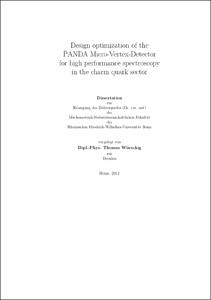Würschig, Thomas: Design optimization of the ¯PANDA Micro-Vertex-Detector for high performance spectroscopy in the charm quark sector. - Bonn, 2011. - Dissertation, Rheinische Friedrich-Wilhelms-Universität Bonn.
Online-Ausgabe in bonndoc: https://nbn-resolving.org/urn:nbn:de:hbz:5N-26230
Online-Ausgabe in bonndoc: https://nbn-resolving.org/urn:nbn:de:hbz:5N-26230
@phdthesis{handle:20.500.11811/5027,
urn: https://nbn-resolving.org/urn:nbn:de:hbz:5N-26230,
author = {{Thomas Würschig}},
title = {Design optimization of the ¯PANDA Micro-Vertex-Detector for high performance spectroscopy in the charm quark sector},
school = {Rheinische Friedrich-Wilhelms-Universität Bonn},
year = 2011,
month = sep,
note = {The ¯PANDA experiment is one of the key projects at the future FAIR facility, which is currently under construction at GSI Darmstadt. Measurements will be performed with antiprotons using a fixed-target setup. The main scope of ¯PANDA is the study of the strong interaction in the charm quark sector. Therefore, high precision spectroscopy of hadronic systems in this energy domain is a prerequisite. The Micro-Vertex-Detector (MVD) as innermost part of the tracking system plays an important role to achieve this goal.
At present, the ¯PANDA project has exceeded the initial phase of conceptual design studies. Based on these results, an optimization of the individual detector subsystems, and thus also for the MVD, is necessary to continue the overall detector development towards its commissioning. Therefore, a comprehensive and realistic detector model must be developed, which on the one hand fulfils the physics requirements but on the other hand also includes feasible engineering solutions. This task is the main scope of the present work. The outcome of these studies will deliver important contributions to the technical design report for the ¯PANDA MVD, which is the next step towards the final detector assembly.
In the first part of this work, main physics aspects of the charm spectroscopy are highlighted and a complete review of the experimental status in this field is given. Afterwards, all relevant details of the ¯PANDA experiment are summarized. The conceptual design and associated hardware developments for the MVD are discussed separately in the following chapters. They deliver basic input for the performed detector optimization, which is presented in the central part. Furthermore, this section describes the development of a comprehensive detector model for the MVD and its introduction into the physics simulation framework of ¯PANDA. The final part contains a compilation of extended simulations with the developed detector model. This includes the determination of basic detector parameters as well as the full simulation of physics channels. Obtained results demonstrate the compliance with all given requirements that warrant the desired physics performance.},
url = {https://hdl.handle.net/20.500.11811/5027}
}
urn: https://nbn-resolving.org/urn:nbn:de:hbz:5N-26230,
author = {{Thomas Würschig}},
title = {Design optimization of the ¯PANDA Micro-Vertex-Detector for high performance spectroscopy in the charm quark sector},
school = {Rheinische Friedrich-Wilhelms-Universität Bonn},
year = 2011,
month = sep,
note = {The ¯PANDA experiment is one of the key projects at the future FAIR facility, which is currently under construction at GSI Darmstadt. Measurements will be performed with antiprotons using a fixed-target setup. The main scope of ¯PANDA is the study of the strong interaction in the charm quark sector. Therefore, high precision spectroscopy of hadronic systems in this energy domain is a prerequisite. The Micro-Vertex-Detector (MVD) as innermost part of the tracking system plays an important role to achieve this goal.
At present, the ¯PANDA project has exceeded the initial phase of conceptual design studies. Based on these results, an optimization of the individual detector subsystems, and thus also for the MVD, is necessary to continue the overall detector development towards its commissioning. Therefore, a comprehensive and realistic detector model must be developed, which on the one hand fulfils the physics requirements but on the other hand also includes feasible engineering solutions. This task is the main scope of the present work. The outcome of these studies will deliver important contributions to the technical design report for the ¯PANDA MVD, which is the next step towards the final detector assembly.
In the first part of this work, main physics aspects of the charm spectroscopy are highlighted and a complete review of the experimental status in this field is given. Afterwards, all relevant details of the ¯PANDA experiment are summarized. The conceptual design and associated hardware developments for the MVD are discussed separately in the following chapters. They deliver basic input for the performed detector optimization, which is presented in the central part. Furthermore, this section describes the development of a comprehensive detector model for the MVD and its introduction into the physics simulation framework of ¯PANDA. The final part contains a compilation of extended simulations with the developed detector model. This includes the determination of basic detector parameters as well as the full simulation of physics channels. Obtained results demonstrate the compliance with all given requirements that warrant the desired physics performance.},
url = {https://hdl.handle.net/20.500.11811/5027}
}






